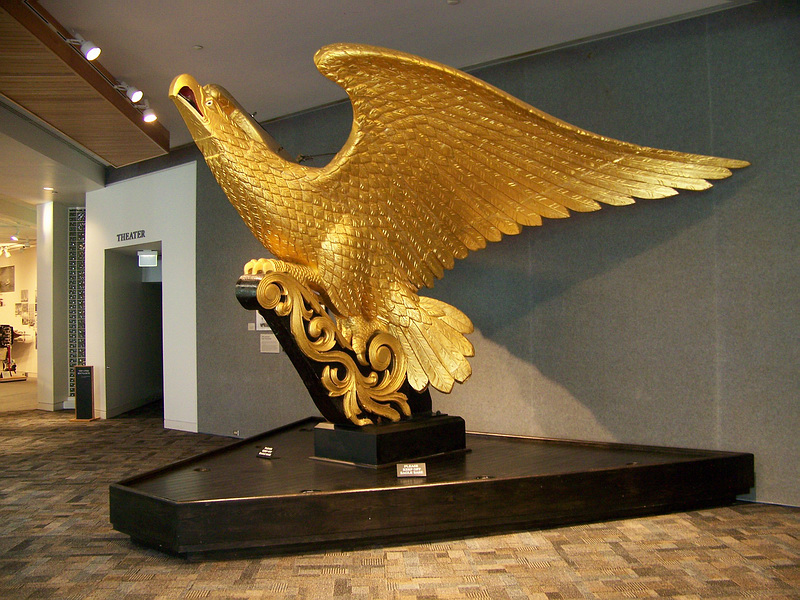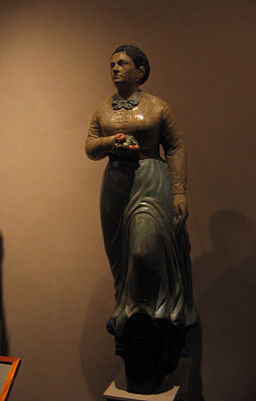Ship figureheads have been around since people first set out to sea. Skilled maritime wood carvers create figureheads to appease a blend of superstition and self-promotion. Often in the form of elaborate wood carvings, they were meant to embody powerful spiritual forces to protect the ship. Also they symbolically show how sailors believed that a ship was not just a thing but an actual living being. This thought also ties in with the idea that in order to find its own way the ship needed to have eyes. These are incredible works of art which are often less considered in this modern age; however there were artists working alongside ship-builders over a long stretch of history - and still are to a limited degree. No ship went to sea without its eyes.
You may tend to think of figureheads as a prelude to hood ornaments - which are also being seen less frequently these days. The figurehead on a ship at first was not just mere adornment, they were meant to represent matters important to seafarers. In Ancient Egypt, for instance, figureheads were perceived to offer protection and vision, in the form of holy bird figures mounted on the prows. Roman ships often made show of their elite fighting capabilities by having a carving of a centurion in place. Phoenicians used the heads of horses as an embodiment of swiftness and Greek ships had boar heads to represent ferocity to frighten possible attackers.
Northern Europeans often decorated their long ships with a serpent figurehead. Some ships also had dragons, dolphins, or bulls. These were meant to fend off enemy ships along with their enemy's guardian spirits. Alternately ornate as opposed to fearsome, the swan became very popular in the 13th century; it was thought to imbue the ships with grace and mobility. The figurehead carvers created for the seafarer a symbol of good luck carved and painted to represent a guard against being lost or otherwise compromised at sea.
Originally mounted on or carved directly onto the stern of the ship, figureheads were changed to the bowsprit following the forecastles taking their place above and protruding out from the ships' stern for a brief period in the middle ages. 17th century warships often had more elaborate designs to denote the relative importance of the ships, sometimes depicting a scene not just a roaring lion for example. In the late 18th century carvings came to represent the name of the ship which proved practical in the manner that many sailors could not read. Feminine forms usually bare-breasted rose in popularity due to sailor superstition that a naked woman would calm a storm at sea.
The industrial changes from sail to steam and from wood to iron in ship technology brought on the gradual decline of the use of figureheads. In the twentieth century ships began to have medallions or shields with figures as side-supports. The loss of the bowsprit, which was just above the usual placement site of a figurehead, is cited as a leading cause for the disappearing figureheads.
In looking over figurehead carvings on ships from ancient times to today, we see much has changed. Some smaller modern ships and yachts will have figureheads according to the desire of the builder or owners. These tend to serve as decorative flourish that conveys a sense of prosperity and pride. Depending on who you ask, the use of a figurehead may just as well hearken back to demonstrating the spirit of the ship and serve to bolster the identity of the ship and its crew.
The figureheads of ships of bygone days are now shown as wood art sculptures on display in nautical museums such as the exhibit of the East India Hall in the Peabody/Essex Museum in Salem, Massachusetts, USA. One could argue that in this way, past all the other meaning and purpose intended for figureheads, that they even serve as lasting symbols of ships similar to the purpose of graveyard statuary.
The art form is not entirely lost and has its own particular facets of construction and problems unique to carvings in wood of this size - imagine working with a 14 ft., 3-ton block of wood to be carved in a way that will display properly at a 45 degree angle! Maritime wood carvers today find themselves commissioned to make figureheads for replica ships and often apply their skills into making smaller versions of figureheads, even desk-top sized ones. Coat of Arms and even totem-poles are other types of wood carvings created with their specialized talents, and they often are called upon for restoration work.
images used are public domain or © their respective owners.
You may tend to think of figureheads as a prelude to hood ornaments - which are also being seen less frequently these days. The figurehead on a ship at first was not just mere adornment, they were meant to represent matters important to seafarers. In Ancient Egypt, for instance, figureheads were perceived to offer protection and vision, in the form of holy bird figures mounted on the prows. Roman ships often made show of their elite fighting capabilities by having a carving of a centurion in place. Phoenicians used the heads of horses as an embodiment of swiftness and Greek ships had boar heads to represent ferocity to frighten possible attackers.
Northern Europeans often decorated their long ships with a serpent figurehead. Some ships also had dragons, dolphins, or bulls. These were meant to fend off enemy ships along with their enemy's guardian spirits. Alternately ornate as opposed to fearsome, the swan became very popular in the 13th century; it was thought to imbue the ships with grace and mobility. The figurehead carvers created for the seafarer a symbol of good luck carved and painted to represent a guard against being lost or otherwise compromised at sea.
 |
| The bow of the Kalmar Nyckel, a replica built in 1997 of the 1625 ship that carried the Swedish settlers that established New Sweden in 1628, now the modern city of Wilmington, Delaware, USA |
The industrial changes from sail to steam and from wood to iron in ship technology brought on the gradual decline of the use of figureheads. In the twentieth century ships began to have medallions or shields with figures as side-supports. The loss of the bowsprit, which was just above the usual placement site of a figurehead, is cited as a leading cause for the disappearing figureheads.
 |
| Eagle figurehead from the USS Lancaster, circa 1880 John Haley Bellamy, carver |
In looking over figurehead carvings on ships from ancient times to today, we see much has changed. Some smaller modern ships and yachts will have figureheads according to the desire of the builder or owners. These tend to serve as decorative flourish that conveys a sense of prosperity and pride. Depending on who you ask, the use of a figurehead may just as well hearken back to demonstrating the spirit of the ship and serve to bolster the identity of the ship and its crew.
 |
| Ship figurehead of Belva Lockwood |
The art form is not entirely lost and has its own particular facets of construction and problems unique to carvings in wood of this size - imagine working with a 14 ft., 3-ton block of wood to be carved in a way that will display properly at a 45 degree angle! Maritime wood carvers today find themselves commissioned to make figureheads for replica ships and often apply their skills into making smaller versions of figureheads, even desk-top sized ones. Coat of Arms and even totem-poles are other types of wood carvings created with their specialized talents, and they often are called upon for restoration work.
 |
| Jack Whitehead - one of the great maritime carvers of the 20th century. |
"Of all the objects made by man, the ship almost achieves a life of its own. When considering a figurehead, therefore, it is important to remember the ship that bore her. The ships have gone, but these wooden angels remain to tell their tales to those who care to listen." - Martin Jeffery, Ship Carver
images used are public domain or © their respective owners.








.png)


0 comments: